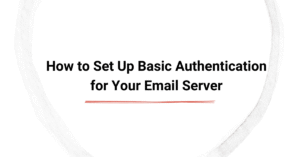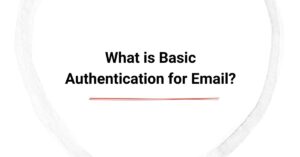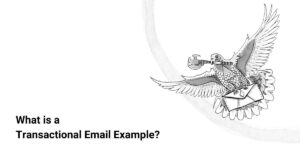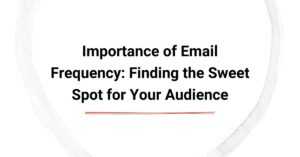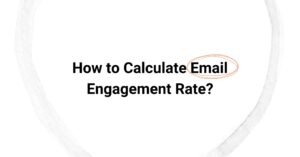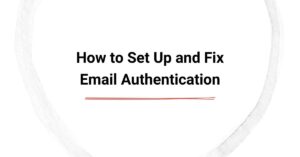Is 30% a good email engagement rate? That depends on what you're measuring, who you're sending to, and what you're expecting from the campaign. In an email marketing campaign, 30% might be excellent, average, or even cause for worry depending on how you define "engagement."
Some marketers use engagement rate to mean opens. Others look at clicks, conversions, or time spent reading. Without understanding exactly what you're measuring, it's easy to misinterpret your email performance benchmarks.
In this guide, we’ll explore what 30% really means when it comes to your email marketing metrics. We’ll compare it to common industry standards, explain how it varies depending on list type and campaign format, and give practical strategies for improving your audience interaction rate.
If you want to track your campaign engagement effectively, it starts with using clear metrics and the right expectations.

What Is an Email Engagement Rate?
Email engagement rate is the percentage of recipients who interact with your email. This could include opening the message, clicking a link, replying, or taking a conversion action.
Different tools and email marketers define this metric differently, which is why it’s essential to understand which engagement metrics you're working with.
Engagement Metrics Commonly Measured:
- Open Rate: The percentage of delivered emails that were opened.
- Click-Through Rate (CTR): The percentage of recipients who clicked a link in your email.
- Click-to-Open Rate (CTOR): The number of clicks divided by opens. Shows how engaging the content is after the open.
- Conversion Rate: The percentage of people who completed your desired action (e.g., purchased, signed up, downloaded).
These are your core email marketing metrics, and each paints a slightly different picture of how your email performed.
Is 30% a Good Email Engagement Rate?
Let’s break it down by metric.
30% Open Rate
In email marketing, open rates vary between 15% and 25% across most industries. If your campaign is hitting a 30% email open rate, you're doing better than average. It suggests:
- Your email subject line resonated.
- Your timing was on point.
- Your list quality is high.
It could also reflect higher engagement in smaller or more targeted campaigns.
30% Click-Through Rate
This is where things get interesting. A 30% email click rate is almost unheard of unless you’re running a hyper-targeted, transactional email. The average CTR sits between 2% and 6%, even in highly active lists.
If you’re seeing a 30% CTR:
- You likely had one strong CTA.
- Your offer matched subscriber intent.
- The email design and messaging were frictionless.
This level of campaign engagement is rare and usually short-lived unless part of a very niche, warmed-up audience.
30% Click-to-Open Rate
CTORs typically range from 10% to 20%. A 30% click-to-open rate means your content delivered exactly what your subject line promised. It’s a strong signal that your email content is relevant, well-formatted, and action-driven.
This could be from a:
- Re-engagement email with a powerful incentive
- Behavioral trigger message
- One-off exclusive offer to loyal users
30% Bounce or Unsubscribe Rate?
If the 30% you’re seeing is related to unsubscribes or bounces, there’s a problem. Bounce rates should be under 2%. Unsubscribes should stay under 0.5%.
Always double-check what your dashboard is actually measuring. Misreading email KPIs can lead to the wrong conclusions and next steps.
Industry Benchmarks for Comparison
Let’s see how a 30% email engagement rate compares across industries.
Ecommerce
- Open Rate: 18–25%
- CTR: 2–4%
- Verdict: 30% open rates indicate excellent performance. 30% click rate = extraordinary; likely campaign-specific.
SaaS / B2B
- Open Rate: 20–30%
- CTR: 3–7%
- Verdict: A 30% open rate is solid. CTR this high would only come from very engaged users or transactional messages.
Nonprofits
- Open Rate: 25–35%
- CTR: 2–6%
- Verdict: A 30% open rate is fairly standard. A 30% CTR is far above average, often achieved during fundraising drives or cause-based actions.
Media & Publishing
- Open Rate: 20–40%
- CTR: 1–3%
- Verdict: Newsletters with loyal readership can reach 30% opens. CTRs rarely exceed 5%.
As always, email performance benchmarks should be reviewed in context: list source, message type, and audience expectations matter.
Why Context Matters in Interpreting Engagement
Metrics alone don’t tell the full story unless you understand the factors that influence them. When analyzing your email marketing metrics, it’s important to consider several surrounding variables that shape how your audience interacts with your emails. Without context, a 30% engagement rate might be misleading or incomplete.
Type of Campaign
The kind of email you send heavily impacts your campaign engagement levels. For example, transactional emails like abandoned cart reminders or order confirmations typically have much higher email open rates and click rates than general newsletters or promotional blasts.
Transactional emails target users at a moment of intent, so they naturally drive more interaction. In contrast, newsletters or or email blasts often aim to inform or nurture, resulting in varied and usually lower engagement. Comparing these different email types without context can lead to incorrect conclusions about your overall email performance.
List Size & Source
Your email list size and its origin play a crucial role in your email engagement metrics. Smaller, organically grown email list subscribers who are loyal customers or have actively opted in tend to have higher open and click rates. A 30% open rate on a small, highly engaged list can be less impactful than a 20% open rate on a larger list with solid interaction across thousands of recipients.
Purchased or cold lists, on the other hand, usually suffer from lower engagement and higher bounce rates, which skew the interpretation of your email performance benchmarks. Maintaining a healthy, verified list is fundamental to achieving meaningful audience interaction rates.
Audience Segment
Who you’re emailing makes a big difference. Are your messages going to returning customers, warm leads, or new subscribers? Returning customers often have higher engagement because they’re familiar with your brand and have shown prior interest or intent.
New leads or cold contacts typically require more nurturing to drive meaningful interaction. This variation underscores the importance of segmentation and personalized customer journeys to boost your email KPIs.
Tailoring content and timing to your target audience helps maintain or improve your engagement rates and provides clearer insight into what’s working.
Understanding these contextual elements alongside your raw metrics will give you a more accurate picture of your campaign’s true effectiveness.
How to Maintain or Improve a 30% Engagement Rate
Let’s say you’ve hit 30% in one of your campaigns. How do you maintain that momentum and keep your email engagement metrics trending upward? It requires consistent attention to audience preferences and ongoing optimization. Here are proven tactics to help you sustain or boost your results.
Use Segmentation & Personalization
Break your list into segments by behavior, geography, lifecycle, or purchase history. This allows you to tailor content specifically to each group’s interests and needs.
Use dynamic content and tailored subject lines to speak directly to each segment’s motivations. Personalized emails tend to generate higher audience interaction rates because recipients feel the message is relevant to them, increasing both open rates and click rates.
Test Subject Lines & Preview Text
Run A/B tests consistently to identify which language, tone, and structure generate better open rates and engagement. Small changes in wording or emoji use can have a surprising impact on email open rates. Don’t just test once rather make it an ongoing process to adapt to shifting audience preferences and stay ahead of fatigue or trends.
Send at Optimal Times
Timing matters when it comes to campaign engagement. Analyze your past campaign data to determine when your audience is most responsive, whether that’s day of the week, time of day, or even seasonally. Optimal send times can vary by industry and audience, so continuous review and adjustment based on your email marketing metrics will help you capture attention at peak moments.
Optimize Email Design & CTA Placement
Keep your designs mobile-first since most users will read on their phones. Use strong, action-driven CTAs early in the message to guide readers toward your desired outcome without having to scroll too far.
Limit distractions by keeping layouts clean and use bullet points or short paragraphs for scannability. Well-placed CTAs improve click rates and overall email performance benchmarks.
Clean Your List Regularly
High bounce rates or inactive contacts drag down your deliverability and lower your email KPIs. Removing disengaged users every 60–90 days keeps your list fresh and ensures your emails land in inboxes rather than spam folders. Regular list hygiene also improves the accuracy of your email engagement metrics, giving you a clearer picture of true audience interaction.
Common Pitfalls When Interpreting 30% Engagement
Metrics look great? Be careful not to over-celebrate without deeper context.
Assuming Opens = Success
Open rates are inflated on Apple devices due to privacy rules. Always pair them with CTR and CTOR to get a more accurate performance picture.
Misattributing Results
Did the email ride the wave of a trending topic? Was there an external promo running? Is it seasonal behavior? Don’t assume the result will repeat without testing.
Neglecting Deliverability
Great metrics on a small segment might mask poor inbox placement across your full list. Regularly monitor domain reputation and run inbox placement tests.
Conclusion
Is 30% a Good Email Engagement Rate?
Yes, when it’s a 30% open rate, you’re ahead of the curve. A 30% click-through rate? That’s elite performance. But a 30% unsubscribe or bounce rate? That’s a red flag.
Context is everything in email performance.
Whether you’re measuring opens, clicks, or conversions, benchmark your metrics against industry standards and your own historical data. Use segmentation, great content, mobile optimization, and smart timing to sustain high campaign engagement.
Need help interpreting your engagement metrics? Book a discovery call with our team of experts.


